Strategic Management Analysis in the Financial Industry: Report
VerifiedAdded on 2021/04/21
|21
|3775
|62
Report
AI Summary
This report provides a comprehensive analysis of strategic management within the financial industry. It begins with an introduction to the industry, highlighting key features such as market size, growth rate, and competitiveness. The report then delves into external factors impacting the industry, employing PESTLE and Porter's Five Forces analyses to assess political, economic, social, technological, legal, and environmental influences, as well as competitive dynamics. Furthermore, the report examines changes within financial companies, particularly focusing on innovation in resources and capabilities. The analysis covers the global significance of the financial industry, market structure, and the impact of globalization and technology. Finally, the report offers real-life examples of financial institutions and their strategic adaptations, providing a well-rounded understanding of the subject.
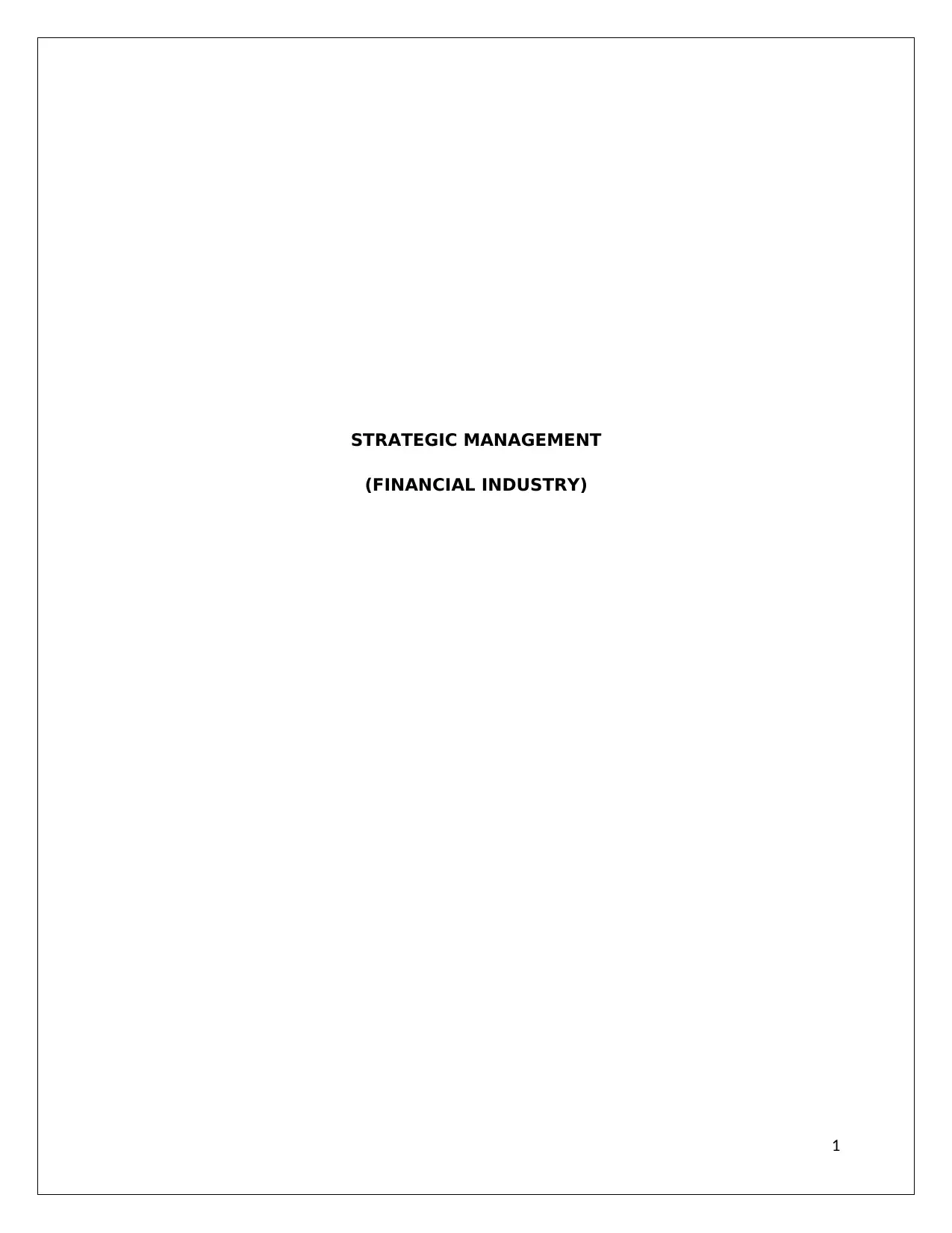
STRATEGIC MANAGEMENT
(FINANCIAL INDUSTRY)
1
(FINANCIAL INDUSTRY)
1
Paraphrase This Document
Need a fresh take? Get an instant paraphrase of this document with our AI Paraphraser
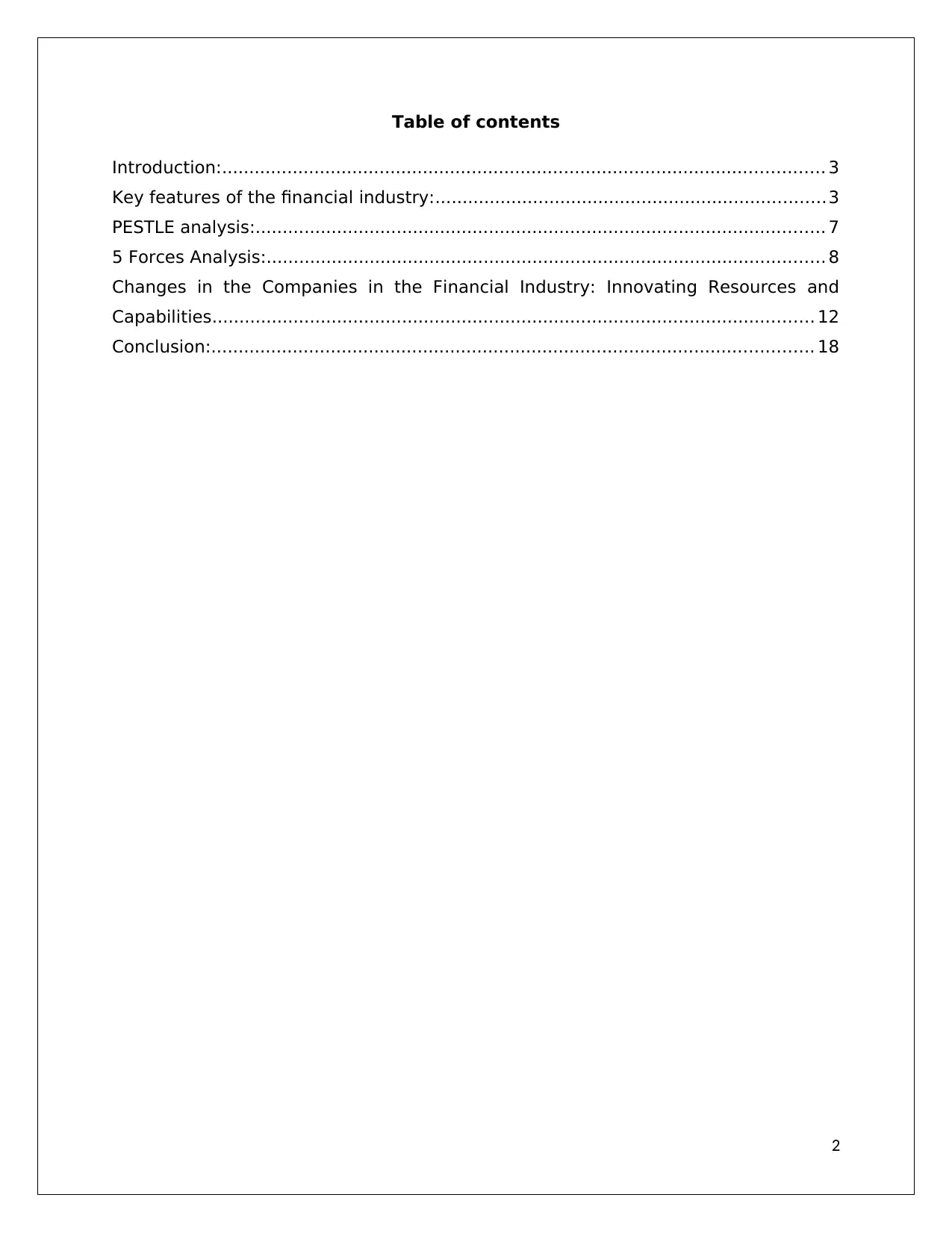
Table of contents
Introduction:............................................................................................................... 3
Key features of the financial industry:........................................................................3
PESTLE analysis:......................................................................................................... 7
5 Forces Analysis:....................................................................................................... 8
Changes in the Companies in the Financial Industry: Innovating Resources and
Capabilities............................................................................................................... 12
Conclusion:............................................................................................................... 18
2
Introduction:............................................................................................................... 3
Key features of the financial industry:........................................................................3
PESTLE analysis:......................................................................................................... 7
5 Forces Analysis:....................................................................................................... 8
Changes in the Companies in the Financial Industry: Innovating Resources and
Capabilities............................................................................................................... 12
Conclusion:............................................................................................................... 18
2
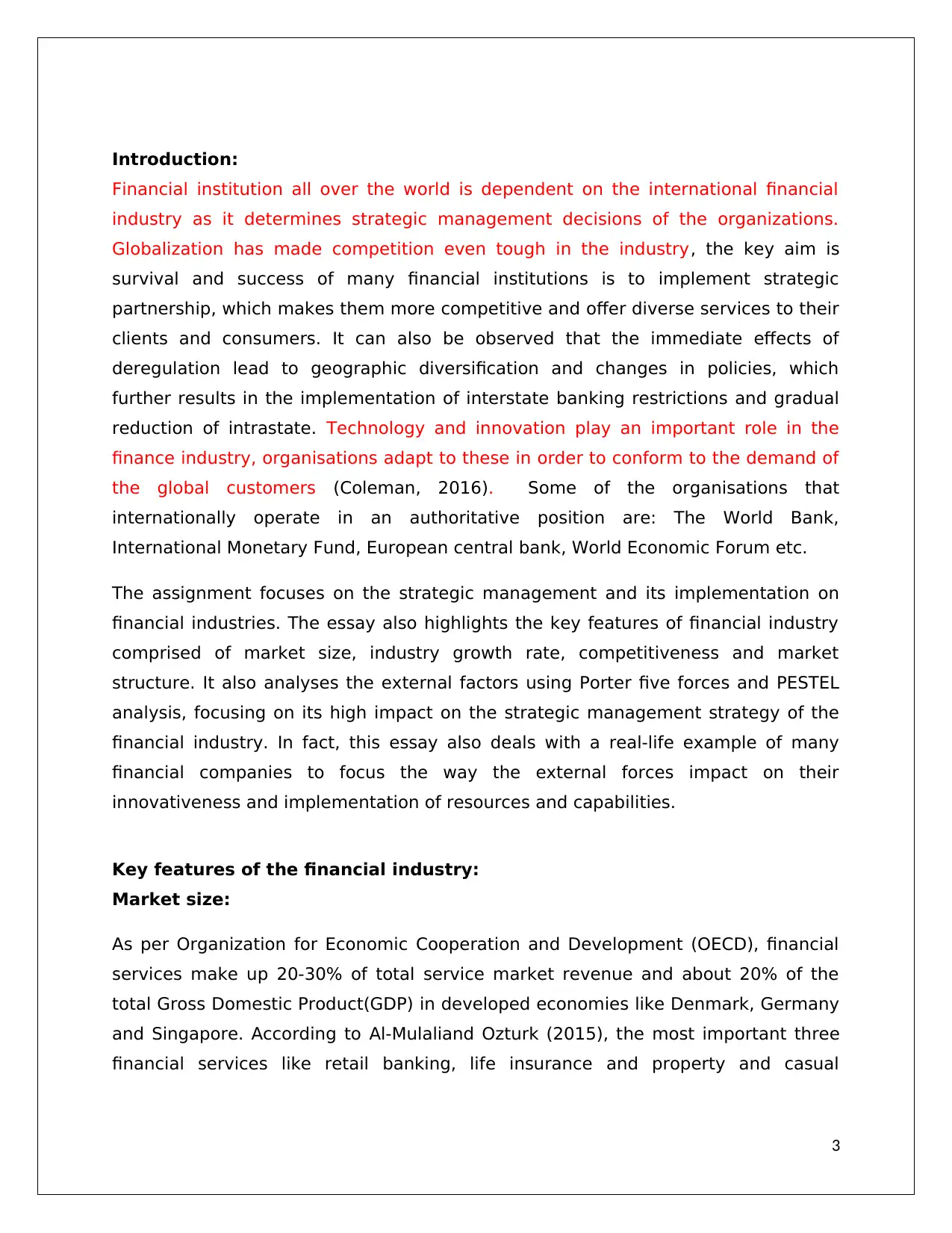
Introduction:
Financial institution all over the world is dependent on the international financial
industry as it determines strategic management decisions of the organizations.
Globalization has made competition even tough in the industry, the key aim is
survival and success of many financial institutions is to implement strategic
partnership, which makes them more competitive and offer diverse services to their
clients and consumers. It can also be observed that the immediate effects of
deregulation lead to geographic diversification and changes in policies, which
further results in the implementation of interstate banking restrictions and gradual
reduction of intrastate. Technology and innovation play an important role in the
finance industry, organisations adapt to these in order to conform to the demand of
the global customers (Coleman, 2016). Some of the organisations that
internationally operate in an authoritative position are: The World Bank,
International Monetary Fund, European central bank, World Economic Forum etc.
The assignment focuses on the strategic management and its implementation on
financial industries. The essay also highlights the key features of financial industry
comprised of market size, industry growth rate, competitiveness and market
structure. It also analyses the external factors using Porter five forces and PESTEL
analysis, focusing on its high impact on the strategic management strategy of the
financial industry. In fact, this essay also deals with a real-life example of many
financial companies to focus the way the external forces impact on their
innovativeness and implementation of resources and capabilities.
Key features of the financial industry:
Market size:
As per Organization for Economic Cooperation and Development (OECD), financial
services make up 20-30% of total service market revenue and about 20% of the
total Gross Domestic Product(GDP) in developed economies like Denmark, Germany
and Singapore. According to Al-Mulaliand Ozturk (2015), the most important three
financial services like retail banking, life insurance and property and casual
3
Financial institution all over the world is dependent on the international financial
industry as it determines strategic management decisions of the organizations.
Globalization has made competition even tough in the industry, the key aim is
survival and success of many financial institutions is to implement strategic
partnership, which makes them more competitive and offer diverse services to their
clients and consumers. It can also be observed that the immediate effects of
deregulation lead to geographic diversification and changes in policies, which
further results in the implementation of interstate banking restrictions and gradual
reduction of intrastate. Technology and innovation play an important role in the
finance industry, organisations adapt to these in order to conform to the demand of
the global customers (Coleman, 2016). Some of the organisations that
internationally operate in an authoritative position are: The World Bank,
International Monetary Fund, European central bank, World Economic Forum etc.
The assignment focuses on the strategic management and its implementation on
financial industries. The essay also highlights the key features of financial industry
comprised of market size, industry growth rate, competitiveness and market
structure. It also analyses the external factors using Porter five forces and PESTEL
analysis, focusing on its high impact on the strategic management strategy of the
financial industry. In fact, this essay also deals with a real-life example of many
financial companies to focus the way the external forces impact on their
innovativeness and implementation of resources and capabilities.
Key features of the financial industry:
Market size:
As per Organization for Economic Cooperation and Development (OECD), financial
services make up 20-30% of total service market revenue and about 20% of the
total Gross Domestic Product(GDP) in developed economies like Denmark, Germany
and Singapore. According to Al-Mulaliand Ozturk (2015), the most important three
financial services like retail banking, life insurance and property and casual
3
⊘ This is a preview!⊘
Do you want full access?
Subscribe today to unlock all pages.

Trusted by 1+ million students worldwide
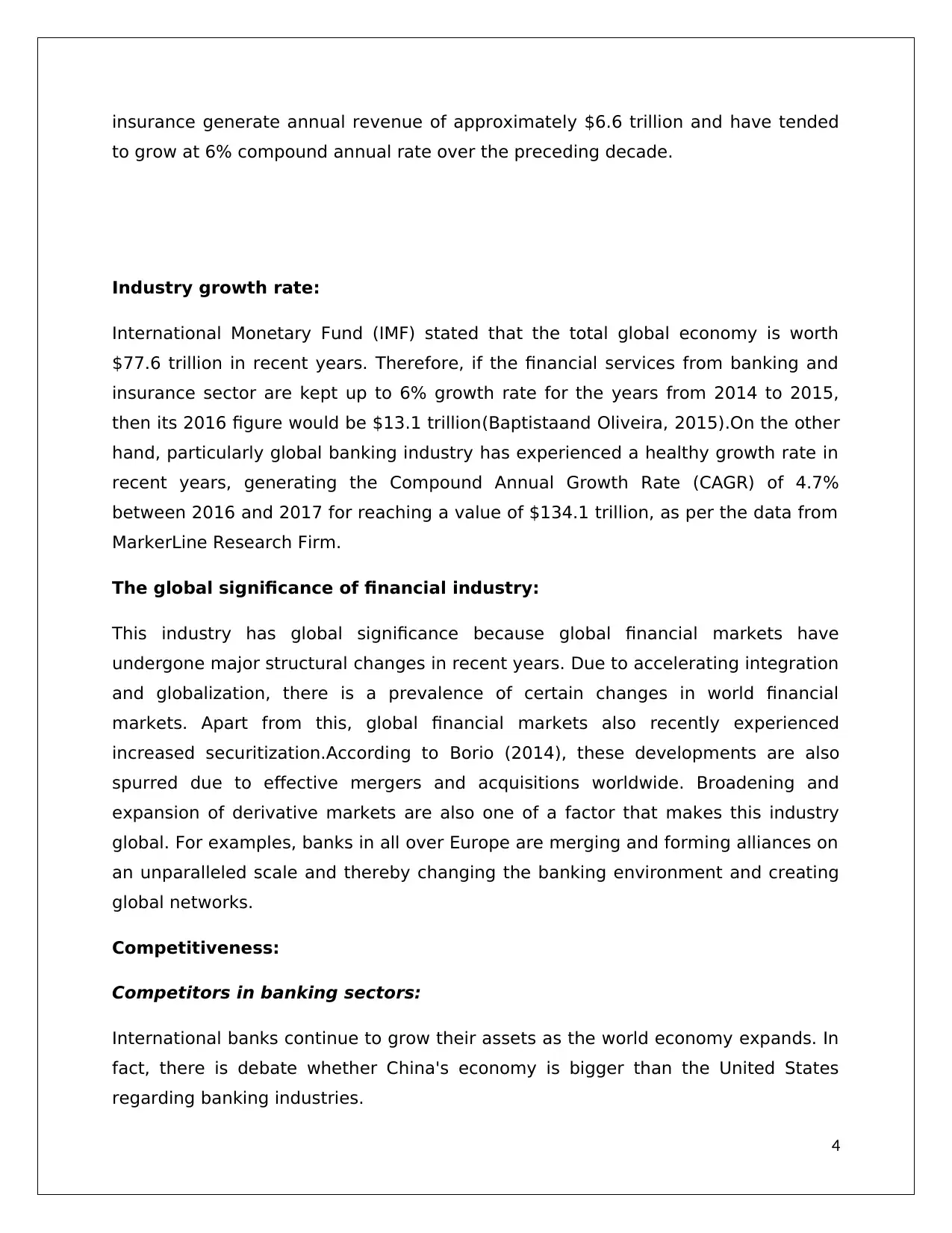
insurance generate annual revenue of approximately $6.6 trillion and have tended
to grow at 6% compound annual rate over the preceding decade.
Industry growth rate:
International Monetary Fund (IMF) stated that the total global economy is worth
$77.6 trillion in recent years. Therefore, if the financial services from banking and
insurance sector are kept up to 6% growth rate for the years from 2014 to 2015,
then its 2016 figure would be $13.1 trillion(Baptistaand Oliveira, 2015).On the other
hand, particularly global banking industry has experienced a healthy growth rate in
recent years, generating the Compound Annual Growth Rate (CAGR) of 4.7%
between 2016 and 2017 for reaching a value of $134.1 trillion, as per the data from
MarkerLine Research Firm.
The global significance of financial industry:
This industry has global significance because global financial markets have
undergone major structural changes in recent years. Due to accelerating integration
and globalization, there is a prevalence of certain changes in world financial
markets. Apart from this, global financial markets also recently experienced
increased securitization.According to Borio (2014), these developments are also
spurred due to effective mergers and acquisitions worldwide. Broadening and
expansion of derivative markets are also one of a factor that makes this industry
global. For examples, banks in all over Europe are merging and forming alliances on
an unparalleled scale and thereby changing the banking environment and creating
global networks.
Competitiveness:
Competitors in banking sectors:
International banks continue to grow their assets as the world economy expands. In
fact, there is debate whether China's economy is bigger than the United States
regarding banking industries.
4
to grow at 6% compound annual rate over the preceding decade.
Industry growth rate:
International Monetary Fund (IMF) stated that the total global economy is worth
$77.6 trillion in recent years. Therefore, if the financial services from banking and
insurance sector are kept up to 6% growth rate for the years from 2014 to 2015,
then its 2016 figure would be $13.1 trillion(Baptistaand Oliveira, 2015).On the other
hand, particularly global banking industry has experienced a healthy growth rate in
recent years, generating the Compound Annual Growth Rate (CAGR) of 4.7%
between 2016 and 2017 for reaching a value of $134.1 trillion, as per the data from
MarkerLine Research Firm.
The global significance of financial industry:
This industry has global significance because global financial markets have
undergone major structural changes in recent years. Due to accelerating integration
and globalization, there is a prevalence of certain changes in world financial
markets. Apart from this, global financial markets also recently experienced
increased securitization.According to Borio (2014), these developments are also
spurred due to effective mergers and acquisitions worldwide. Broadening and
expansion of derivative markets are also one of a factor that makes this industry
global. For examples, banks in all over Europe are merging and forming alliances on
an unparalleled scale and thereby changing the banking environment and creating
global networks.
Competitiveness:
Competitors in banking sectors:
International banks continue to grow their assets as the world economy expands. In
fact, there is debate whether China's economy is bigger than the United States
regarding banking industries.
4
Paraphrase This Document
Need a fresh take? Get an instant paraphrase of this document with our AI Paraphraser
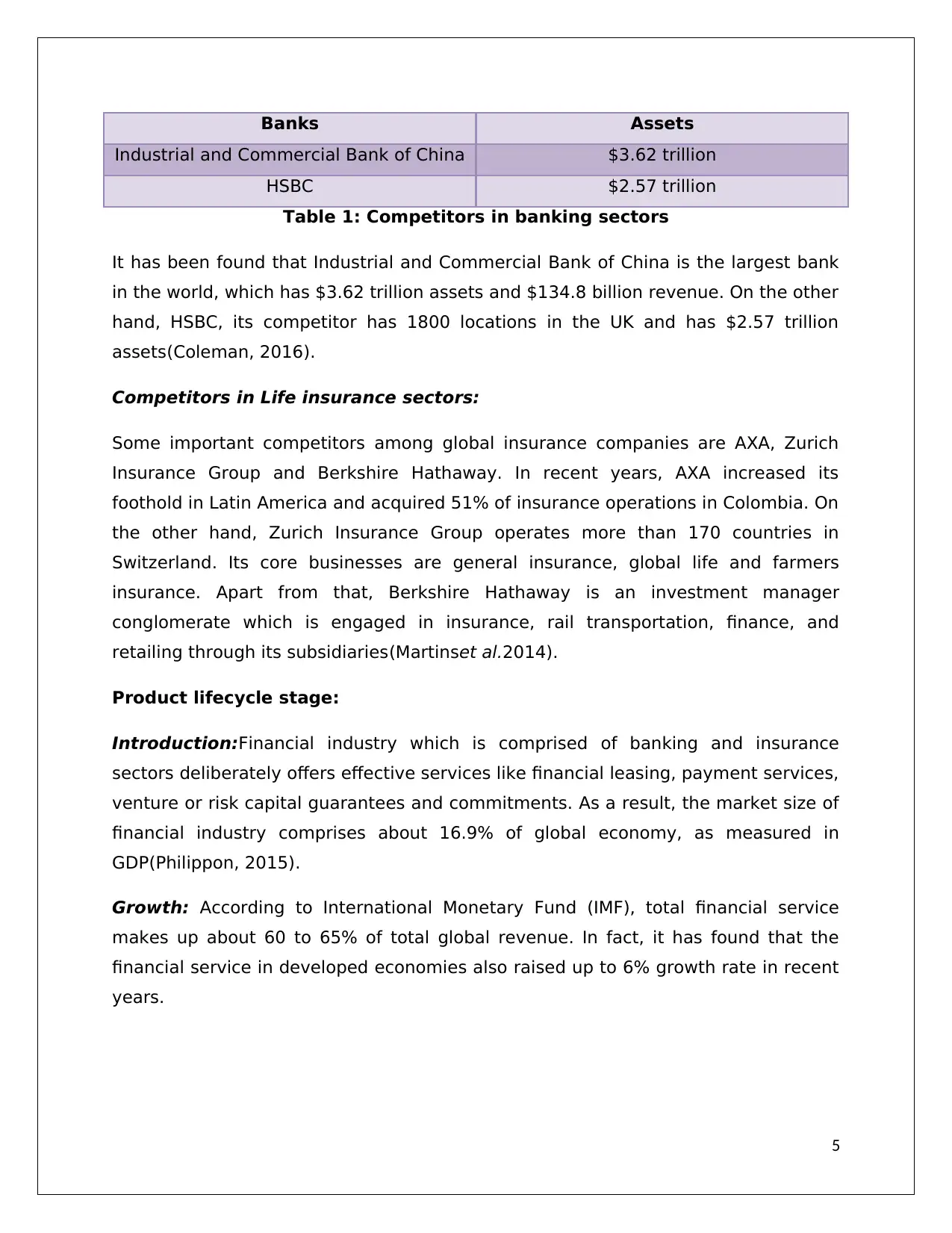
Banks Assets
Industrial and Commercial Bank of China $3.62 trillion
HSBC $2.57 trillion
Table 1: Competitors in banking sectors
It has been found that Industrial and Commercial Bank of China is the largest bank
in the world, which has $3.62 trillion assets and $134.8 billion revenue. On the other
hand, HSBC, its competitor has 1800 locations in the UK and has $2.57 trillion
assets(Coleman, 2016).
Competitors in Life insurance sectors:
Some important competitors among global insurance companies are AXA, Zurich
Insurance Group and Berkshire Hathaway. In recent years, AXA increased its
foothold in Latin America and acquired 51% of insurance operations in Colombia. On
the other hand, Zurich Insurance Group operates more than 170 countries in
Switzerland. Its core businesses are general insurance, global life and farmers
insurance. Apart from that, Berkshire Hathaway is an investment manager
conglomerate which is engaged in insurance, rail transportation, finance, and
retailing through its subsidiaries(Martinset al.2014).
Product lifecycle stage:
Introduction:Financial industry which is comprised of banking and insurance
sectors deliberately offers effective services like financial leasing, payment services,
venture or risk capital guarantees and commitments. As a result, the market size of
financial industry comprises about 16.9% of global economy, as measured in
GDP(Philippon, 2015).
Growth: According to International Monetary Fund (IMF), total financial service
makes up about 60 to 65% of total global revenue. In fact, it has found that the
financial service in developed economies also raised up to 6% growth rate in recent
years.
5
Industrial and Commercial Bank of China $3.62 trillion
HSBC $2.57 trillion
Table 1: Competitors in banking sectors
It has been found that Industrial and Commercial Bank of China is the largest bank
in the world, which has $3.62 trillion assets and $134.8 billion revenue. On the other
hand, HSBC, its competitor has 1800 locations in the UK and has $2.57 trillion
assets(Coleman, 2016).
Competitors in Life insurance sectors:
Some important competitors among global insurance companies are AXA, Zurich
Insurance Group and Berkshire Hathaway. In recent years, AXA increased its
foothold in Latin America and acquired 51% of insurance operations in Colombia. On
the other hand, Zurich Insurance Group operates more than 170 countries in
Switzerland. Its core businesses are general insurance, global life and farmers
insurance. Apart from that, Berkshire Hathaway is an investment manager
conglomerate which is engaged in insurance, rail transportation, finance, and
retailing through its subsidiaries(Martinset al.2014).
Product lifecycle stage:
Introduction:Financial industry which is comprised of banking and insurance
sectors deliberately offers effective services like financial leasing, payment services,
venture or risk capital guarantees and commitments. As a result, the market size of
financial industry comprises about 16.9% of global economy, as measured in
GDP(Philippon, 2015).
Growth: According to International Monetary Fund (IMF), total financial service
makes up about 60 to 65% of total global revenue. In fact, it has found that the
financial service in developed economies also raised up to 6% growth rate in recent
years.
5
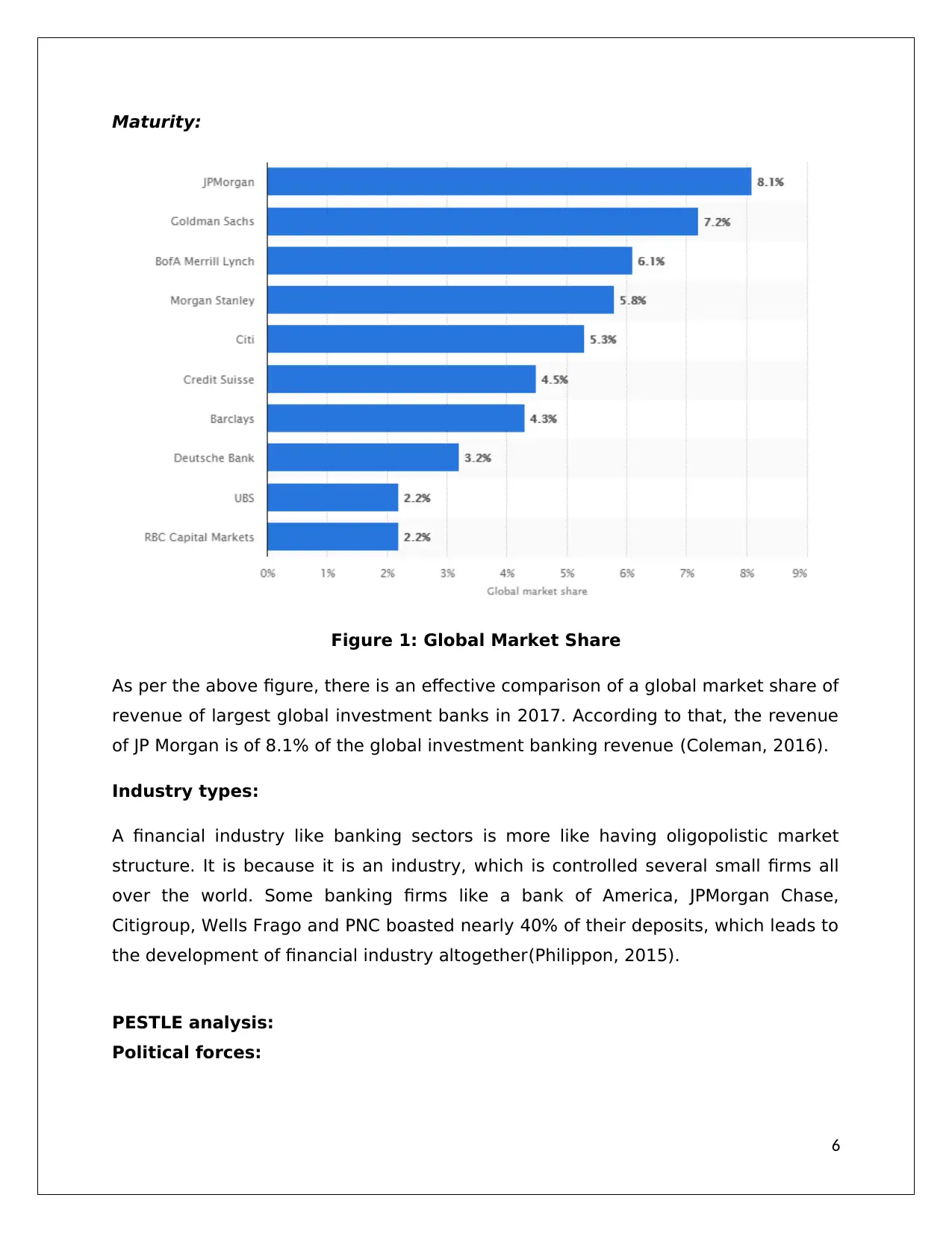
Maturity:
Figure 1: Global Market Share
As per the above figure, there is an effective comparison of a global market share of
revenue of largest global investment banks in 2017. According to that, the revenue
of JP Morgan is of 8.1% of the global investment banking revenue (Coleman, 2016).
Industry types:
A financial industry like banking sectors is more like having oligopolistic market
structure. It is because it is an industry, which is controlled several small firms all
over the world. Some banking firms like a bank of America, JPMorgan Chase,
Citigroup, Wells Frago and PNC boasted nearly 40% of their deposits, which leads to
the development of financial industry altogether(Philippon, 2015).
PESTLE analysis:
Political forces:
6
Figure 1: Global Market Share
As per the above figure, there is an effective comparison of a global market share of
revenue of largest global investment banks in 2017. According to that, the revenue
of JP Morgan is of 8.1% of the global investment banking revenue (Coleman, 2016).
Industry types:
A financial industry like banking sectors is more like having oligopolistic market
structure. It is because it is an industry, which is controlled several small firms all
over the world. Some banking firms like a bank of America, JPMorgan Chase,
Citigroup, Wells Frago and PNC boasted nearly 40% of their deposits, which leads to
the development of financial industry altogether(Philippon, 2015).
PESTLE analysis:
Political forces:
6
⊘ This is a preview!⊘
Do you want full access?
Subscribe today to unlock all pages.

Trusted by 1+ million students worldwide
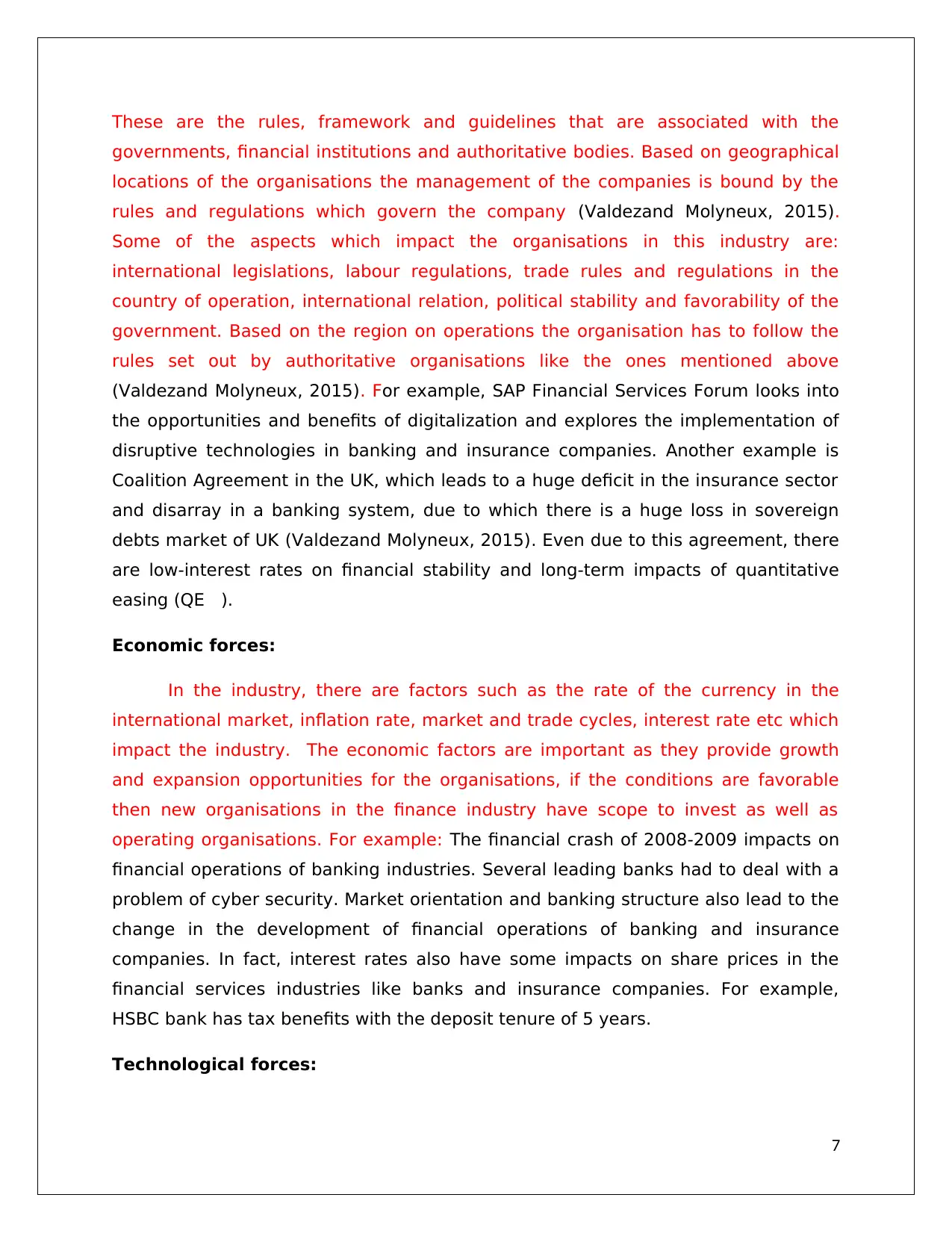
These are the rules, framework and guidelines that are associated with the
governments, financial institutions and authoritative bodies. Based on geographical
locations of the organisations the management of the companies is bound by the
rules and regulations which govern the company (Valdezand Molyneux, 2015).
Some of the aspects which impact the organisations in this industry are:
international legislations, labour regulations, trade rules and regulations in the
country of operation, international relation, political stability and favorability of the
government. Based on the region on operations the organisation has to follow the
rules set out by authoritative organisations like the ones mentioned above
(Valdezand Molyneux, 2015). For example, SAP Financial Services Forum looks into
the opportunities and benefits of digitalization and explores the implementation of
disruptive technologies in banking and insurance companies. Another example is
Coalition Agreement in the UK, which leads to a huge deficit in the insurance sector
and disarray in a banking system, due to which there is a huge loss in sovereign
debts market of UK (Valdezand Molyneux, 2015). Even due to this agreement, there
are low-interest rates on financial stability and long-term impacts of quantitative
easing (QE ).
Economic forces:
In the industry, there are factors such as the rate of the currency in the
international market, inflation rate, market and trade cycles, interest rate etc which
impact the industry. The economic factors are important as they provide growth
and expansion opportunities for the organisations, if the conditions are favorable
then new organisations in the finance industry have scope to invest as well as
operating organisations. For example: The financial crash of 2008-2009 impacts on
financial operations of banking industries. Several leading banks had to deal with a
problem of cyber security. Market orientation and banking structure also lead to the
change in the development of financial operations of banking and insurance
companies. In fact, interest rates also have some impacts on share prices in the
financial services industries like banks and insurance companies. For example,
HSBC bank has tax benefits with the deposit tenure of 5 years.
Technological forces:
7
governments, financial institutions and authoritative bodies. Based on geographical
locations of the organisations the management of the companies is bound by the
rules and regulations which govern the company (Valdezand Molyneux, 2015).
Some of the aspects which impact the organisations in this industry are:
international legislations, labour regulations, trade rules and regulations in the
country of operation, international relation, political stability and favorability of the
government. Based on the region on operations the organisation has to follow the
rules set out by authoritative organisations like the ones mentioned above
(Valdezand Molyneux, 2015). For example, SAP Financial Services Forum looks into
the opportunities and benefits of digitalization and explores the implementation of
disruptive technologies in banking and insurance companies. Another example is
Coalition Agreement in the UK, which leads to a huge deficit in the insurance sector
and disarray in a banking system, due to which there is a huge loss in sovereign
debts market of UK (Valdezand Molyneux, 2015). Even due to this agreement, there
are low-interest rates on financial stability and long-term impacts of quantitative
easing (QE ).
Economic forces:
In the industry, there are factors such as the rate of the currency in the
international market, inflation rate, market and trade cycles, interest rate etc which
impact the industry. The economic factors are important as they provide growth
and expansion opportunities for the organisations, if the conditions are favorable
then new organisations in the finance industry have scope to invest as well as
operating organisations. For example: The financial crash of 2008-2009 impacts on
financial operations of banking industries. Several leading banks had to deal with a
problem of cyber security. Market orientation and banking structure also lead to the
change in the development of financial operations of banking and insurance
companies. In fact, interest rates also have some impacts on share prices in the
financial services industries like banks and insurance companies. For example,
HSBC bank has tax benefits with the deposit tenure of 5 years.
Technological forces:
7
Paraphrase This Document
Need a fresh take? Get an instant paraphrase of this document with our AI Paraphraser
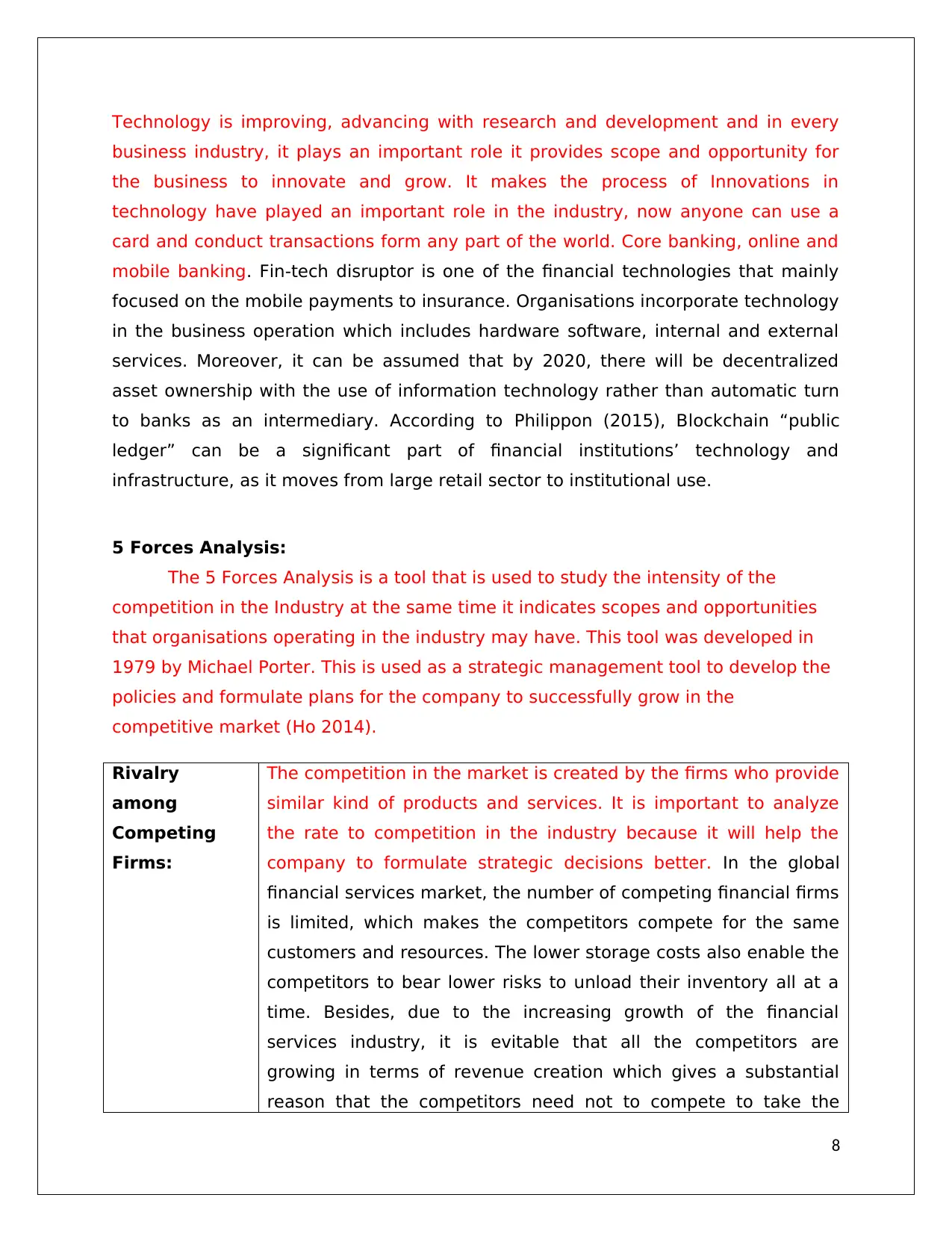
Technology is improving, advancing with research and development and in every
business industry, it plays an important role it provides scope and opportunity for
the business to innovate and grow. It makes the process of Innovations in
technology have played an important role in the industry, now anyone can use a
card and conduct transactions form any part of the world. Core banking, online and
mobile banking. Fin-tech disruptor is one of the financial technologies that mainly
focused on the mobile payments to insurance. Organisations incorporate technology
in the business operation which includes hardware software, internal and external
services. Moreover, it can be assumed that by 2020, there will be decentralized
asset ownership with the use of information technology rather than automatic turn
to banks as an intermediary. According to Philippon (2015), Blockchain “public
ledger” can be a significant part of financial institutions’ technology and
infrastructure, as it moves from large retail sector to institutional use.
5 Forces Analysis:
The 5 Forces Analysis is a tool that is used to study the intensity of the
competition in the Industry at the same time it indicates scopes and opportunities
that organisations operating in the industry may have. This tool was developed in
1979 by Michael Porter. This is used as a strategic management tool to develop the
policies and formulate plans for the company to successfully grow in the
competitive market (Ho 2014).
Rivalry
among
Competing
Firms:
The competition in the market is created by the firms who provide
similar kind of products and services. It is important to analyze
the rate to competition in the industry because it will help the
company to formulate strategic decisions better. In the global
financial services market, the number of competing financial firms
is limited, which makes the competitors compete for the same
customers and resources. The lower storage costs also enable the
competitors to bear lower risks to unload their inventory all at a
time. Besides, due to the increasing growth of the financial
services industry, it is evitable that all the competitors are
growing in terms of revenue creation which gives a substantial
reason that the competitors need not to compete to take the
8
business industry, it plays an important role it provides scope and opportunity for
the business to innovate and grow. It makes the process of Innovations in
technology have played an important role in the industry, now anyone can use a
card and conduct transactions form any part of the world. Core banking, online and
mobile banking. Fin-tech disruptor is one of the financial technologies that mainly
focused on the mobile payments to insurance. Organisations incorporate technology
in the business operation which includes hardware software, internal and external
services. Moreover, it can be assumed that by 2020, there will be decentralized
asset ownership with the use of information technology rather than automatic turn
to banks as an intermediary. According to Philippon (2015), Blockchain “public
ledger” can be a significant part of financial institutions’ technology and
infrastructure, as it moves from large retail sector to institutional use.
5 Forces Analysis:
The 5 Forces Analysis is a tool that is used to study the intensity of the
competition in the Industry at the same time it indicates scopes and opportunities
that organisations operating in the industry may have. This tool was developed in
1979 by Michael Porter. This is used as a strategic management tool to develop the
policies and formulate plans for the company to successfully grow in the
competitive market (Ho 2014).
Rivalry
among
Competing
Firms:
The competition in the market is created by the firms who provide
similar kind of products and services. It is important to analyze
the rate to competition in the industry because it will help the
company to formulate strategic decisions better. In the global
financial services market, the number of competing financial firms
is limited, which makes the competitors compete for the same
customers and resources. The lower storage costs also enable the
competitors to bear lower risks to unload their inventory all at a
time. Besides, due to the increasing growth of the financial
services industry, it is evitable that all the competitors are
growing in terms of revenue creation which gives a substantial
reason that the competitors need not to compete to take the
8
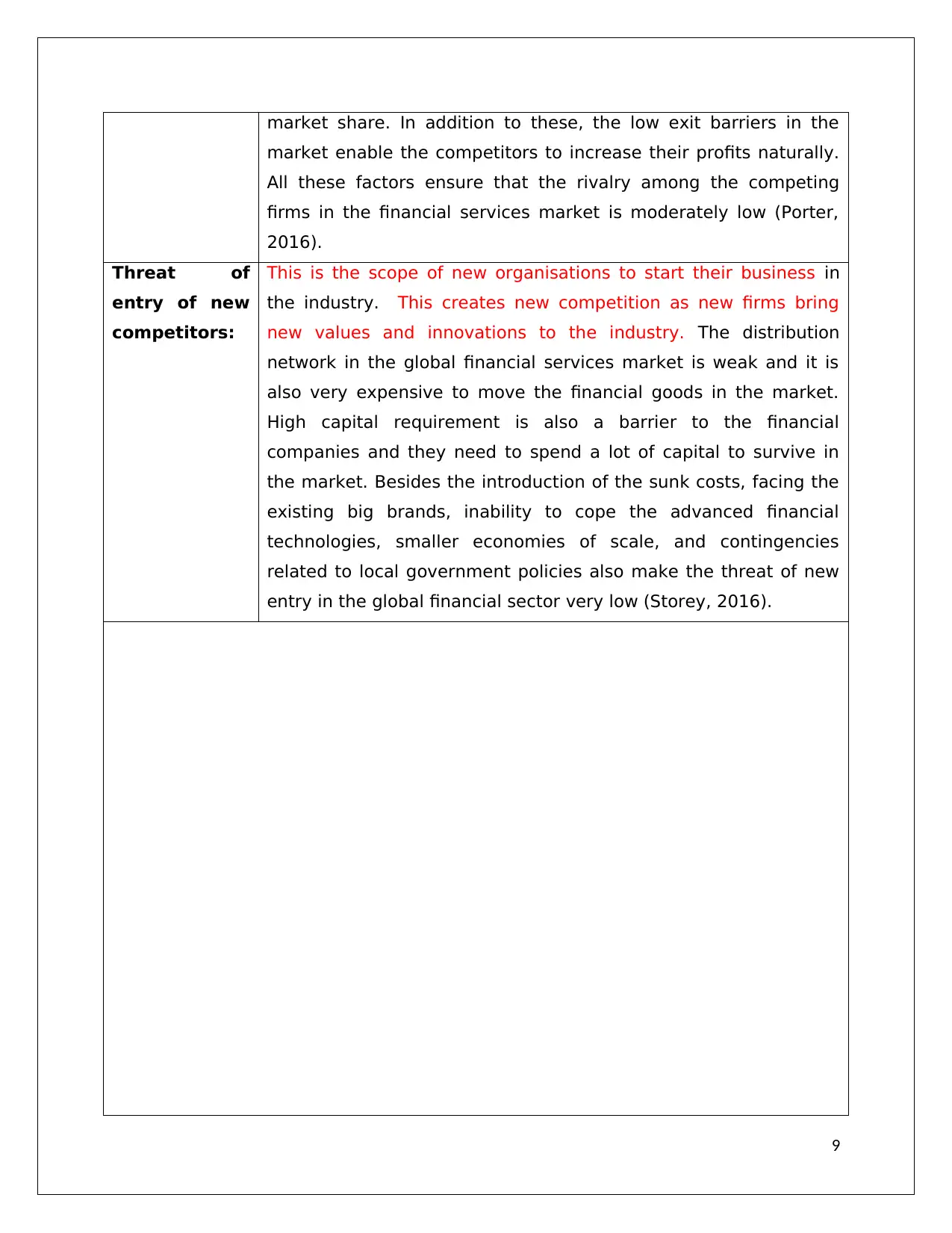
market share. In addition to these, the low exit barriers in the
market enable the competitors to increase their profits naturally.
All these factors ensure that the rivalry among the competing
firms in the financial services market is moderately low (Porter,
2016).
Threat of
entry of new
competitors:
This is the scope of new organisations to start their business in
the industry. This creates new competition as new firms bring
new values and innovations to the industry. The distribution
network in the global financial services market is weak and it is
also very expensive to move the financial goods in the market.
High capital requirement is also a barrier to the financial
companies and they need to spend a lot of capital to survive in
the market. Besides the introduction of the sunk costs, facing the
existing big brands, inability to cope the advanced financial
technologies, smaller economies of scale, and contingencies
related to local government policies also make the threat of new
entry in the global financial sector very low (Storey, 2016).
9
RivalryamongFirms:ModeratelyLowThreatofNewEntry:LowThreatofSubstitutes:LowBargainingPowerofConsumers:ModerateBargainingPowerofSuppliers:ModeratelyLow
market enable the competitors to increase their profits naturally.
All these factors ensure that the rivalry among the competing
firms in the financial services market is moderately low (Porter,
2016).
Threat of
entry of new
competitors:
This is the scope of new organisations to start their business in
the industry. This creates new competition as new firms bring
new values and innovations to the industry. The distribution
network in the global financial services market is weak and it is
also very expensive to move the financial goods in the market.
High capital requirement is also a barrier to the financial
companies and they need to spend a lot of capital to survive in
the market. Besides the introduction of the sunk costs, facing the
existing big brands, inability to cope the advanced financial
technologies, smaller economies of scale, and contingencies
related to local government policies also make the threat of new
entry in the global financial sector very low (Storey, 2016).
9
RivalryamongFirms:ModeratelyLowThreatofNewEntry:LowThreatofSubstitutes:LowBargainingPowerofConsumers:ModerateBargainingPowerofSuppliers:ModeratelyLow
⊘ This is a preview!⊘
Do you want full access?
Subscribe today to unlock all pages.

Trusted by 1+ million students worldwide
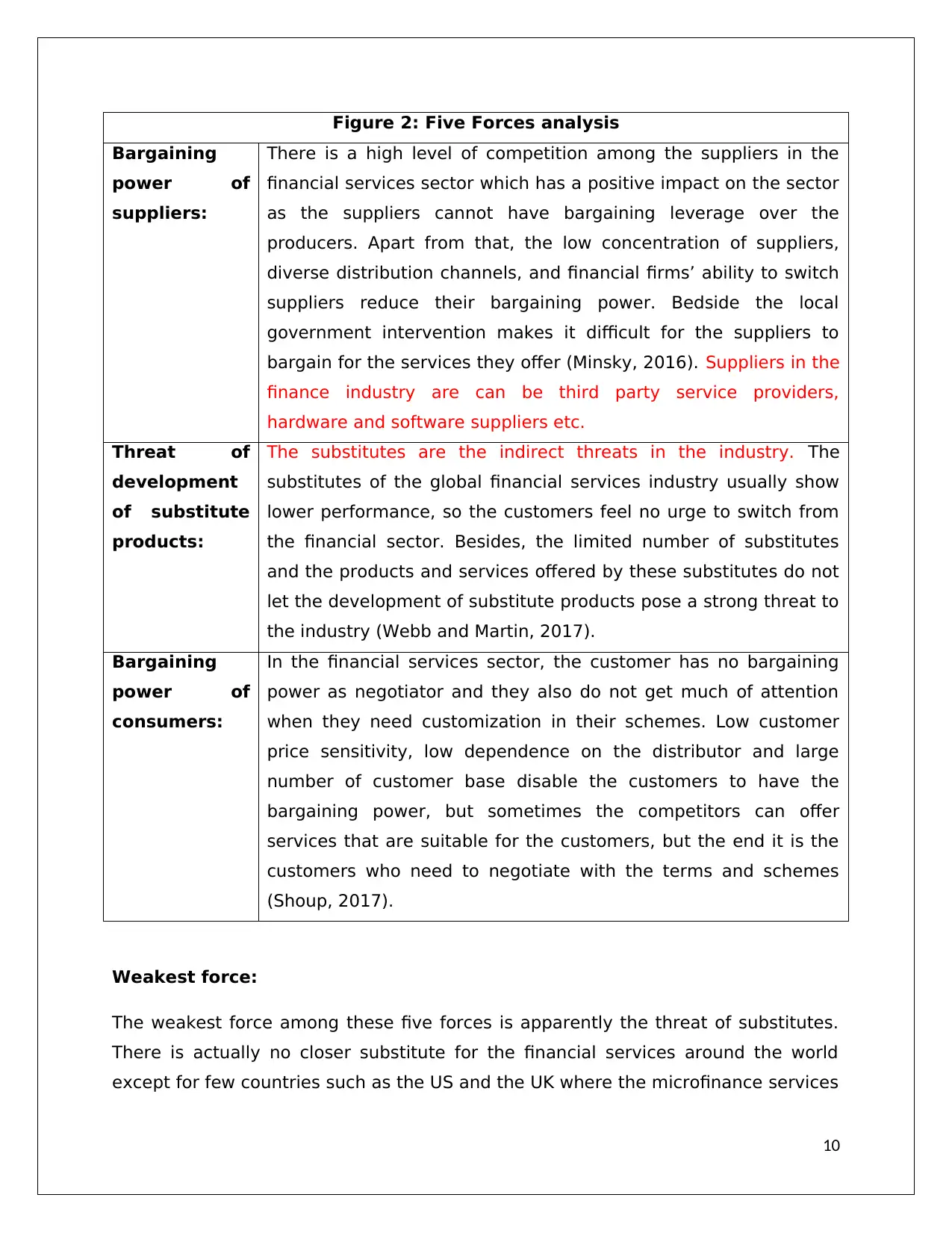
Figure 2: Five Forces analysis
Bargaining
power of
suppliers:
There is a high level of competition among the suppliers in the
financial services sector which has a positive impact on the sector
as the suppliers cannot have bargaining leverage over the
producers. Apart from that, the low concentration of suppliers,
diverse distribution channels, and financial firms’ ability to switch
suppliers reduce their bargaining power. Bedside the local
government intervention makes it difficult for the suppliers to
bargain for the services they offer (Minsky, 2016). Suppliers in the
finance industry are can be third party service providers,
hardware and software suppliers etc.
Threat of
development
of substitute
products:
The substitutes are the indirect threats in the industry. The
substitutes of the global financial services industry usually show
lower performance, so the customers feel no urge to switch from
the financial sector. Besides, the limited number of substitutes
and the products and services offered by these substitutes do not
let the development of substitute products pose a strong threat to
the industry (Webb and Martin, 2017).
Bargaining
power of
consumers:
In the financial services sector, the customer has no bargaining
power as negotiator and they also do not get much of attention
when they need customization in their schemes. Low customer
price sensitivity, low dependence on the distributor and large
number of customer base disable the customers to have the
bargaining power, but sometimes the competitors can offer
services that are suitable for the customers, but the end it is the
customers who need to negotiate with the terms and schemes
(Shoup, 2017).
Weakest force:
The weakest force among these five forces is apparently the threat of substitutes.
There is actually no closer substitute for the financial services around the world
except for few countries such as the US and the UK where the microfinance services
10
Bargaining
power of
suppliers:
There is a high level of competition among the suppliers in the
financial services sector which has a positive impact on the sector
as the suppliers cannot have bargaining leverage over the
producers. Apart from that, the low concentration of suppliers,
diverse distribution channels, and financial firms’ ability to switch
suppliers reduce their bargaining power. Bedside the local
government intervention makes it difficult for the suppliers to
bargain for the services they offer (Minsky, 2016). Suppliers in the
finance industry are can be third party service providers,
hardware and software suppliers etc.
Threat of
development
of substitute
products:
The substitutes are the indirect threats in the industry. The
substitutes of the global financial services industry usually show
lower performance, so the customers feel no urge to switch from
the financial sector. Besides, the limited number of substitutes
and the products and services offered by these substitutes do not
let the development of substitute products pose a strong threat to
the industry (Webb and Martin, 2017).
Bargaining
power of
consumers:
In the financial services sector, the customer has no bargaining
power as negotiator and they also do not get much of attention
when they need customization in their schemes. Low customer
price sensitivity, low dependence on the distributor and large
number of customer base disable the customers to have the
bargaining power, but sometimes the competitors can offer
services that are suitable for the customers, but the end it is the
customers who need to negotiate with the terms and schemes
(Shoup, 2017).
Weakest force:
The weakest force among these five forces is apparently the threat of substitutes.
There is actually no closer substitute for the financial services around the world
except for few countries such as the US and the UK where the microfinance services
10
Paraphrase This Document
Need a fresh take? Get an instant paraphrase of this document with our AI Paraphraser
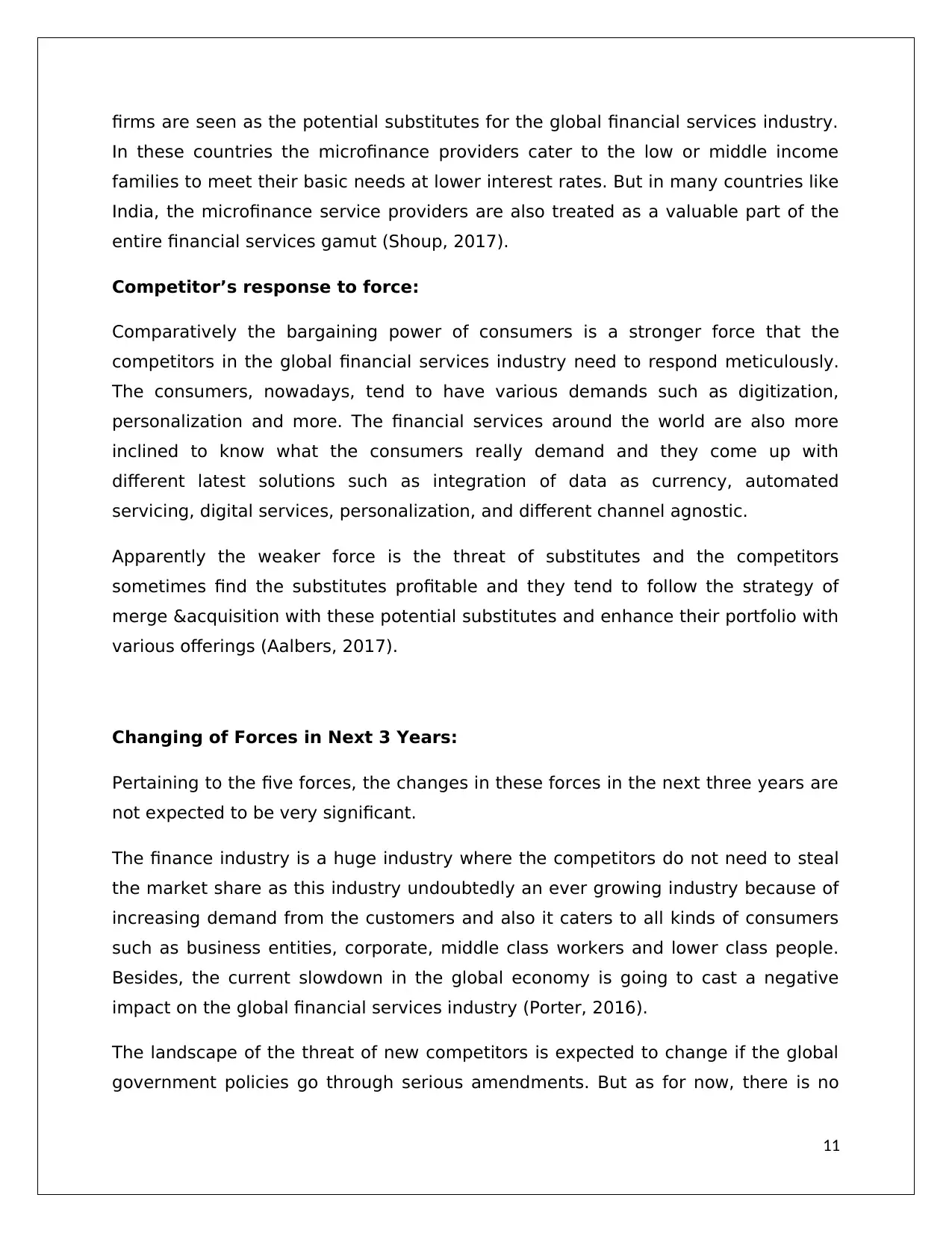
firms are seen as the potential substitutes for the global financial services industry.
In these countries the microfinance providers cater to the low or middle income
families to meet their basic needs at lower interest rates. But in many countries like
India, the microfinance service providers are also treated as a valuable part of the
entire financial services gamut (Shoup, 2017).
Competitor’s response to force:
Comparatively the bargaining power of consumers is a stronger force that the
competitors in the global financial services industry need to respond meticulously.
The consumers, nowadays, tend to have various demands such as digitization,
personalization and more. The financial services around the world are also more
inclined to know what the consumers really demand and they come up with
different latest solutions such as integration of data as currency, automated
servicing, digital services, personalization, and different channel agnostic.
Apparently the weaker force is the threat of substitutes and the competitors
sometimes find the substitutes profitable and they tend to follow the strategy of
merge &acquisition with these potential substitutes and enhance their portfolio with
various offerings (Aalbers, 2017).
Changing of Forces in Next 3 Years:
Pertaining to the five forces, the changes in these forces in the next three years are
not expected to be very significant.
The finance industry is a huge industry where the competitors do not need to steal
the market share as this industry undoubtedly an ever growing industry because of
increasing demand from the customers and also it caters to all kinds of consumers
such as business entities, corporate, middle class workers and lower class people.
Besides, the current slowdown in the global economy is going to cast a negative
impact on the global financial services industry (Porter, 2016).
The landscape of the threat of new competitors is expected to change if the global
government policies go through serious amendments. But as for now, there is no
11
In these countries the microfinance providers cater to the low or middle income
families to meet their basic needs at lower interest rates. But in many countries like
India, the microfinance service providers are also treated as a valuable part of the
entire financial services gamut (Shoup, 2017).
Competitor’s response to force:
Comparatively the bargaining power of consumers is a stronger force that the
competitors in the global financial services industry need to respond meticulously.
The consumers, nowadays, tend to have various demands such as digitization,
personalization and more. The financial services around the world are also more
inclined to know what the consumers really demand and they come up with
different latest solutions such as integration of data as currency, automated
servicing, digital services, personalization, and different channel agnostic.
Apparently the weaker force is the threat of substitutes and the competitors
sometimes find the substitutes profitable and they tend to follow the strategy of
merge &acquisition with these potential substitutes and enhance their portfolio with
various offerings (Aalbers, 2017).
Changing of Forces in Next 3 Years:
Pertaining to the five forces, the changes in these forces in the next three years are
not expected to be very significant.
The finance industry is a huge industry where the competitors do not need to steal
the market share as this industry undoubtedly an ever growing industry because of
increasing demand from the customers and also it caters to all kinds of consumers
such as business entities, corporate, middle class workers and lower class people.
Besides, the current slowdown in the global economy is going to cast a negative
impact on the global financial services industry (Porter, 2016).
The landscape of the threat of new competitors is expected to change if the global
government policies go through serious amendments. But as for now, there is no
11
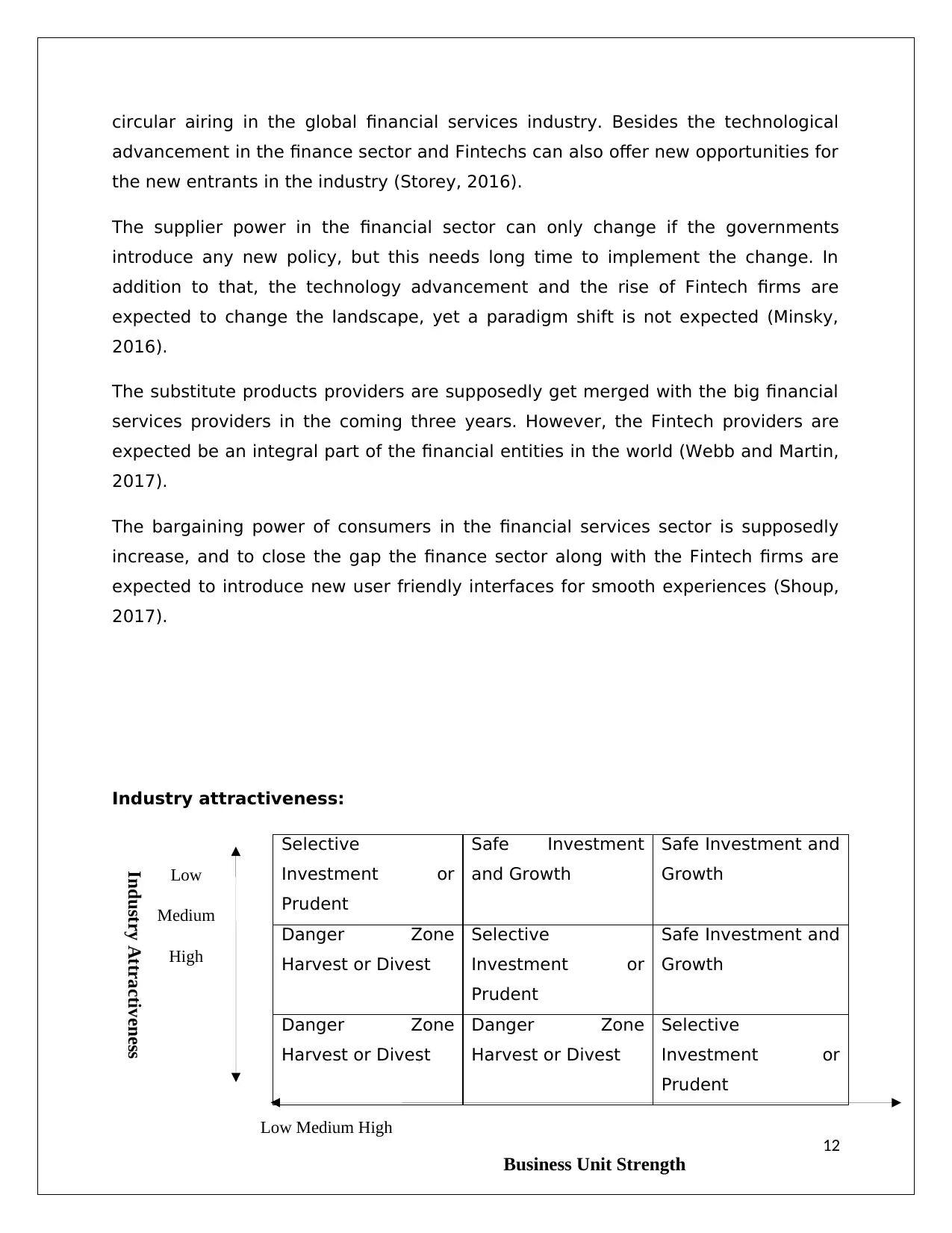
Low Medium High
Low
Medium
High
Industry Attractiveness
Business Unit Strength
circular airing in the global financial services industry. Besides the technological
advancement in the finance sector and Fintechs can also offer new opportunities for
the new entrants in the industry (Storey, 2016).
The supplier power in the financial sector can only change if the governments
introduce any new policy, but this needs long time to implement the change. In
addition to that, the technology advancement and the rise of Fintech firms are
expected to change the landscape, yet a paradigm shift is not expected (Minsky,
2016).
The substitute products providers are supposedly get merged with the big financial
services providers in the coming three years. However, the Fintech providers are
expected be an integral part of the financial entities in the world (Webb and Martin,
2017).
The bargaining power of consumers in the financial services sector is supposedly
increase, and to close the gap the finance sector along with the Fintech firms are
expected to introduce new user friendly interfaces for smooth experiences (Shoup,
2017).
Industry attractiveness:
Selective
Investment or
Prudent
Safe Investment
and Growth
Safe Investment and
Growth
Danger Zone
Harvest or Divest
Selective
Investment or
Prudent
Safe Investment and
Growth
Danger Zone
Harvest or Divest
Danger Zone
Harvest or Divest
Selective
Investment or
Prudent
12
Low
Medium
High
Industry Attractiveness
Business Unit Strength
circular airing in the global financial services industry. Besides the technological
advancement in the finance sector and Fintechs can also offer new opportunities for
the new entrants in the industry (Storey, 2016).
The supplier power in the financial sector can only change if the governments
introduce any new policy, but this needs long time to implement the change. In
addition to that, the technology advancement and the rise of Fintech firms are
expected to change the landscape, yet a paradigm shift is not expected (Minsky,
2016).
The substitute products providers are supposedly get merged with the big financial
services providers in the coming three years. However, the Fintech providers are
expected be an integral part of the financial entities in the world (Webb and Martin,
2017).
The bargaining power of consumers in the financial services sector is supposedly
increase, and to close the gap the finance sector along with the Fintech firms are
expected to introduce new user friendly interfaces for smooth experiences (Shoup,
2017).
Industry attractiveness:
Selective
Investment or
Prudent
Safe Investment
and Growth
Safe Investment and
Growth
Danger Zone
Harvest or Divest
Selective
Investment or
Prudent
Safe Investment and
Growth
Danger Zone
Harvest or Divest
Danger Zone
Harvest or Divest
Selective
Investment or
Prudent
12
⊘ This is a preview!⊘
Do you want full access?
Subscribe today to unlock all pages.

Trusted by 1+ million students worldwide
1 out of 21
Related Documents
Your All-in-One AI-Powered Toolkit for Academic Success.
+13062052269
info@desklib.com
Available 24*7 on WhatsApp / Email
![[object Object]](/_next/static/media/star-bottom.7253800d.svg)
Unlock your academic potential
Copyright © 2020–2025 A2Z Services. All Rights Reserved. Developed and managed by ZUCOL.





